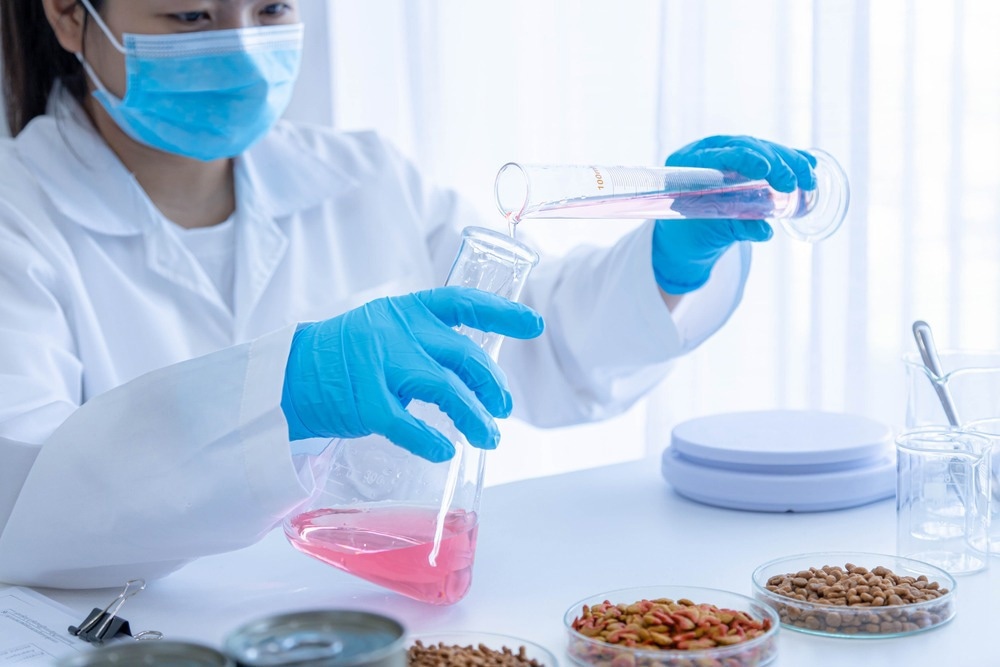Electrospinning is the method of forming fibers from a polymeric solution using a high voltage electric field. The resulting nanofibers have a high specific contact area, a distinct porous structure, and surface properties that are simple to modify. This article describes the fundamental characteristics, advantages, types, and applications of electrospun nanofibers, particularly in food analysis.

Image Credit: SatawatK/Shutterstock.com
Electrospun Nanofibers: Overview and Significance
The electrospinning technique creates fibers ranging in size from 100 nm to a few microns. This one-of-a-kind process has the advantages of simple production machinery, low spinning costs, a diverse range of spinnable components, and an easily controlled process that can constantly fabricate submicron or nanoscale polymeric fibers without the use of high temperature and pressure.
The most fundamental challenge in electrospinning is the formation of fibers under the influence of an electric field force. As a result, the material must have appropriate viscoelasticity, conductance, and surface energy properties that allow it to create a jet and be dragged and refined by an electric field.
Many different kinds of polymers, both synthetic and biological, may be utilized for electrospinning. Electrospun nanofibers may be used in a broad range of industries such as microbiology, medication delivery, sensor creation, and food analysis due to the infinite choices of materials and architectures.
Types of Electrospun Nanofibers Used in Food Applications
Electrospinning of food ingredients such as protein and polysaccharides has emerged as an emergent research area in food systems. Electrospun protein and polysaccharide nanofibers have the distinctive features of nanomaterials as well as high safety and degradation rate when compared to synthetic polymeric materials; hence, they have a wide range of potential uses in food systems.
Due to the complicated supplementary and tertiary architecture of proteins and the low physical strength of the produced nanofibers, electrospinning directly with proteins is very difficult. As a result, proteins are often mixed with polymeric materials for electrospinning.
Electrospun Nanofibers: The Future of Food Analysis
Food analysis is difficult because it involves many specimens and complex matrices. The electrospinning-based micro/nano sensors offer outstanding precision and stability, and they can even do a visual inspection.
The high porosity and large specific surface area of electrospun nanofibrous films, as well as the possibility of surface functionalization, provide ideal conditions for developing novel sensing devices for food and beverage assessment.
Spectroscopy, nucleic acid, and immunoassay are traditional pathogen detection techniques requiring sophisticated sample processing and high monitoring costs. The most recent advancements in nanotechnology, such as electrospinning, provide significant technological improvements in identifying foodborne pathogens.
Electrospun nanofibrous sheets with a high specific surface area and easily adjustable surface characteristics can be utilized to detect antibiotics in food quickly. Moreover, owing to their cheap cost, cytocompatibility, and excellent electron transfer capacity, carbon fibers generated using electrospun polymeric precursors and additional heat treatment may be employed to build electrochemical sensors.
Conventional pesticide residue analytical procedures frequently involve complex operations and time-consuming steps. The detection based on electrospun nanofibers offers the benefits of simplicity, speed, and cheap cost and can identify pesticide residues in complicated food samples.
Recent Research on Food Analysis Applications of Electrospun Nanofibers
Electrospun nanofibers are especially ideal for sensor design and manufacturing due to their great flexibility, large surface area, and biochemical cross-linking capability. As a result, many studies have been conducted in recent years to discover the applicability of electrospun nanofibers for food analysis.
A group of researchers created a droplet-based multiplexed fluorescent particle assay anchored on a nanofibrous platform for identifying food pathogens, as described in a paper published in the journal Biosensors and Bioelectronics. This approach may be utilized for on-site and fast diagnosis, providing true one-step analysis.
A unique electrochemical aptamer detector for the monitoring of penicillin in milk was designed in another work published in the Journal of Food Measurement and Characterization. In monitoring penicillin antibiotics in milk, the electrolytic apt sensor demonstrated excellent repeatability, a broad linear spectrum, and a low sensing limit.
Future Perspective and Avenues for Further Research
As nanofibrous films have high effective contact areas and permeability, and the surface of the films can be adjusted to target particularly, electrospinning is a promising method in food system analysis.
There are certain limitations to the use of electrospinning in food systems. Most electrospinning-based functional food creation and bioactive factor administration are completed in vitro. However, since the in vivo environment is more complicated, the findings of in vitro simulations cannot be used to replace in vivo studies.
As a result, more in vivo tests are required to obtain accurate data to guide business operations. Finally, nanofiber usage laws in the food sector must be revised to guarantee the healthy growth of nanofibers in the areas of food analysis and food safety.
References and Further Reading
Huang, H. et al. (2022). Electrospun Nanofibers: Current Progress and Applications in Food Systems. Journal of Agricultural and Food Chemistry. Available at: https://doi.org/10.1021/acs.jafc.1c05352
Mercante, L. A. et al. (2017). Electrospinning-based (bio)sensors for food and agricultural applications: A review. TrAC Trends in Analytical Chemistry. Available at: https://doi.org/10.1016/j.trac.2017.04.004
Nicolini, A. M. et al. (2015). Droplet-based immunoassay on a ‘sticky’ nanofibrous surface for multiplexed and dual detection of bacteria using smartphones. Biosensors and Bioelectronics. Available at: https://doi.org/10.1016/j.bios.2014.09.040
Vafaye, S. E. et al. (2021). An electrochemical aptasensor based on electrospun carbon nanofiber mat and gold nanoparticles for the sensitive detection of Penicillin in milk. Journal of Food Measurement and Characterization. Available at: https://doi.org/10.1007/s11694-020-00684-x
Disclaimer: The views expressed here are those of the author expressed in their private capacity and do not necessarily represent the views of AZoM.com Limited T/A AZoNetwork the owner and operator of this website. This disclaimer forms part of the Terms and conditions of use of this website.